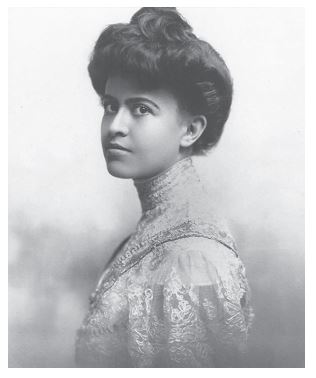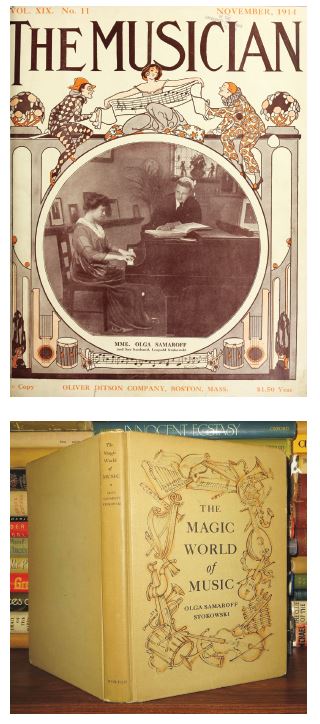A look at the lovely home on the corner of Avenue M and Twenty-fourth Street would not give most passersby a hint that one of the greatest American female pianists once called it home, but it’s true.
 Lucy Mary Olga Agnes Hickenlooper (1880-1948) was born in San Antonio on August 8, 1880 to Jane Lucy Loening (1860-1946) and Carlos Hickenlooper (1854-1936), who was an army clerk at Fort Sam Houston. The small child had a future ahead of her almost as daunting as her given name. The family lived in a house on Avenue C with a maternal grandmother, Lucy Palmer Loening (1841-1931), and two servants.
Lucy Mary Olga Agnes Hickenlooper (1880-1948) was born in San Antonio on August 8, 1880 to Jane Lucy Loening (1860-1946) and Carlos Hickenlooper (1854-1936), who was an army clerk at Fort Sam Houston. The small child had a future ahead of her almost as daunting as her given name. The family lived in a house on Avenue C with a maternal grandmother, Lucy Palmer Loening (1841-1931), and two servants.
When the youngster was six the entire family, which now included George Hickenlooper (1885-1948), moved to Houston. Two years later in 1888 they relocated to Galveston.
Both adult females in the home were talented pianists and began giving lessons in their series of rented homes. Carlos secured a job as a correspondent at Thomas Goggan’s music store, probably due to the women’s musical connections in the community.
In 1892, the Hickenlooper family built a two-story Victorian style home at 2327 Avenue M, just blocks from the Ursuline Academy where Lucy attended school. In addition to her schoolwork, she was tutored in music by her strict grandmother. The family had been shocked when Lucy began improvising tunes on the keyboard by the age of three, displaying a natural aptitude.
At the age of 14, Lucy left school and went to Paris, France, with her grandmother to study music. Despite a gruff reception by professors who believed that Americans were not meant to be musicians, within one year she became a first American woman to win a scholarship to study at the Paris Conservatoire National de Musique.
After her graduation in 1898, she and her grandmother went to Berlin, Germany, where the elder woman had once performed concerts. While there, Lucy worked with a Russian mentor and became enamored with the Russian culture.
While they were away from America, the Great Storm of 1900 struck Galveston Island, thankfully sparing the lives of their other family members.
The young pianist met Russian engineer Boris Loutsky (1865-1943), an early designer of internal combustion engines, and the young couple traveled to New York City in January 1901 to be married before making a home in St. Petersburg, Russia.
For the next three years, she assumed the duties of a wife and relinquished her plans for a music career, but she devoted her spare time to studying chamber music, orchestral scores, and performing with friends.
The Hickenlooper family remaining in the United States left Galveston in 1904 to move to St. Louis, Missouri. When Lucy divorced her husband that same year on grounds of cruelty, she returned to live with them.
The move also presented an opportunity to pursue a concert career. On the advice of her manager, Henry Wolfsohn, she abandoned her dauntingly long given name for a more exotic professional one.
She made her professional American debut as Madame Olga Samaroff, the name of a distant ancestor, in January 1905, at Carnegie Hall with the New York Symphony Orchestra. Positive reviews of the performance led to multiple private engagements, and a London debut the following May.
Her concert career flourished internationally beginning in 1906, and she became one of the first female pianists to make recordings, starting in 1908–first with Welte Mignon Company in Germany and later with Victor Talking Machine Company in New Jersey. Her later recordings became highly prized by music lovers.
A severe illness in 1910 resulted in a hiatus from performing, and she returned to the family home in St. Louis to recuperate.
In 1911, Samaroff married English-born conductor Leopold Stokowski (1882-1977) and once again gave up performing. When she met Stokowski, he was an unknown church music director. She was instrumental in the development of his career, utilizing her powerful connections to obtain his appointment as conductor of the Philadelphia Orchestra.
After spending the first two years of their marriage entirely supporting her husband’s career, she began to perform again, in 1913, and became the first American pianist to perform all thirty-two Beethoven sonatas in public.
Samaroff also performed in Galveston many times including at Scottish Rite in 1915.
The tall slender beauty with brown eyes was outspoken about the importance of music in society and often punctuated her concerts with “notes” or spoken explanations about features of each piece. This approach was received enthusiastically by audiences, who felt they had become privy to the thought processes of a brilliant artist.
She performed with most of the leading American orchestras as well as those of the major cities of Europe, playing with many famous musicians. Some tours included as many as 70 performances per season.
As busy as their performance schedules were, the couple managed to have one daughter, Sonya Maria Noel Stokowsky, in 1921. The family wasn’t destined to be a happy one however, as the couple divorced two years later due to Stokowski’s infidelities.
After the divorce, Samaroff and her daughter purportedly took refuge with friends, including George Gershwin, Irving Berlin, and Dorothy Parker. It did not take long before she resumed performing and exploring new opportunities.
Samaroff was selected as the first American-born member of the piano faculty of the Julliard School in New York in 1924, and she retained the position for the rest of her life.
 Unfortunately, the talented musician injured her shoulder in a fall in her apartment in 1925, forcing her to retire from performing concert tours.
She devoted herself to teaching and working with young artists, incorporating European influences from her past without the harsh approaches to instruction that she endured. Her daughter Sonya was also reaching an age that required more of her attention, and Lucy was happy to devote the extra time to her.
Unfortunately, the talented musician injured her shoulder in a fall in her apartment in 1925, forcing her to retire from performing concert tours.
She devoted herself to teaching and working with young artists, incorporating European influences from her past without the harsh approaches to instruction that she endured. Her daughter Sonya was also reaching an age that required more of her attention, and Lucy was happy to devote the extra time to her.
Always eager to share her enthusiasm for music, and her knowledge about the subject, Samaroff became the first woman to serve as music critic for The New York Evening Post from 1926 to 1928.
In the effort to provide more opportunities beyond her direct students, she established the Schubert Memorial Foundation in 1928, the first competition which provided professional performance opportunities solely for American music students, who were often discriminated against internationally and by the larger concert venues.
In 1932, she also created Layman’s Music Courses which educated audiences in the study and appreciation of music. Samaroff published four books for the course: The Layman’s Music Book, The Magic World of Music, A Musical Manual, and The Listener’s Music Book, in addition to her autobiography An American Musician’s Story. She also lectured and appeared on educational radio and television broadcasts speaking about the subject of music.
Samaroff organized the Musician’s Emergency Aid during the Great Depression, and she was chosen as one of the twenty-five musicians to work for a Works Progress Administration (WPA) project in 1935.
President Franklin D. Roosevelt appointed her as a member of the Advisory Committee on Music to the Department of State in 1944.
When her portrait was painted by Orlando Rouland, a noted American artist, it made headlines across the country. Rouland gained fame for executing portraits of such luminaries as Thomas Edison and Theodore Roosevelt, and it was considered an honor to be his subject.
After years of breaking international and gender barriers in the performance world of classical music, Olga Samaroff died in New York City on May 17, 1948. She suffered a heart attack alone in her apartment, after giving several private piano lessons. It seems fitting that her last day was spent sharing her exceptional gift.
The internationally acclaimed pianist who spent her formative years in Galveston is remembered with a historical marker that stands outside of the home where she once lived at 2327 Avenue M.